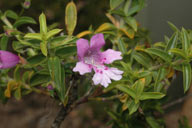In Flower This Week
A weekly news sheet prepared by a Gardens' volunteer.
Numbers before each plant refer to temporary IFTW labels in the gardens.
Numbers in square brackets [ ] refer to garden bed Sections. Plants in flower are in bold type.
View past issues of 'In Flower This Week'.
25 June 2014
Hemiandra pungens click for larger image |
We will stick closely to the Visitors Information Centre area this week and concentrate on the flowers in pots and the endangered plant area. You do not have to walk far in the Gardens to see interesting and beautiful plants in flower.
- Lechenaultia formosa [Section 221] in a pot on the right is a small attractive plant with close grey-green foliage and bright red flowers with orange centres. Both this plant and the next have been flowering for months.
- Hemiandra pungens [Section 221], also in a pot on the right and commonly known as Snakebush, is a trailing plant with bright green leaves and mauve tubular flowers which is endemic to south-western Western Australia where it grows on rocky outcrops.
- Brachyscome tatei [Section 221] in the same pot area is considered rare in the wild. It occurs in the centre of Australia and is also known as the Nullarbor Daisy. It has yellowish buds which develop into a white daisy flower with a yellow centre.
- Follow the path and past the Joseph Banks bust on your right in a pot is Anigozanthos hybrid ‘Bush Volcano’ [Section 174], which has long lasting rusty-red paw flowers.
- Banksia heliantha [Section 174], which used to be known as Oak-leaved Dryandra before the reclassification of all dryandras to banksias, is in a pot on your right. It has stiff spiky foliage and a magnificent green immature flower head erupting from a rusty red base. The flowers will turn yellow as they mature.
- Spyridium burragorang [Section 174], on your right is a long-flowering, medium-sized shrub with unusual white bracts surrounding a central pinkish-brown cluster of flowers. Its occurrence is confined to the Lake Burragorang district and it is considered rare in the wild.
- Epacris longiflora [Section 174] on your right has long thin tube-like white flowers on a straggly light green bush.
- Grevillea rosmarinifolia ‘Scarlet Sprite’ [Section 174] on your right is just coming into bloom with bright red clusters of flowers on a neat bush of fine green foliage.
- Also on your right is Woollsia pungens [Section 174], a straggly light green bush with terminal white flower heads which have a strong scent.
- Continuing on your right is Epacris impressa [Section 174], another straggly bush with bright pink tubular flowers. The form seen here is often referred to as Pink Heath, and is the floral emblem of the state of Victoria.
- Prostanthera phylicifolia [Section 210], or Spiked Mint-bush, on your left has masses of small mauve flowers on a lax bush which scrambles down a bank.
- Continue around the corner to your right to see Zieria formosa [Section 174], or Shapely Zieria, with soft grey foliage contrasting harmoniously with the small light pink clusters of flowers. Both surfaces of the leaves are covered in a dense, velvety layer of hair, giving the leaves a silvery appearance. This plant is endangered in the wild.
- Thryptomene saxicola [Section 174] makes a strong display with airy arching sprays of tiny pink flowers on fine green foliage. It is found on granite outcrops and hills in the south of Western Australia.
- At the base of the steps you will find Allocasuarina littoralis [Section 174] with fluffy red blooms on a sparse tree with many cones remaining on the branches. Allocasuarina littoralis is one of the most widespread species in eastern Australia, extending along the coast south from the tip of Cape York Peninsula in Queensland to southern parts of Tasmania.
- Myoporum turbinatum [Section 221] on the left of the steps has tiny white star flowers in high contrast to the dark linear foliage. It is native to Western Australia and is threatened in the wild.
Rosalind Walcott
![Director of National Parks [logo]](../../../../images/dnp_90px.gif)







